Citizen Science as an Innovative Approach to Analyze Spatial and Temporal Influences on Nitrate Pollution of Water Bodies: Results of a Participatory Research Project in Germany
Abstract
:1. Introduction
1.1. Nitrate—Between Necessity and Excess
1.2. A Citizen Science Project to Investigate the Nitrate Pollution of Water Bodies
1.3. Theoretical Background and Hypotheses
2. Materials and Methods
2.1. Sampling Area
2.2. Sampling Design and Measurement Method
2.3. Quantity and Distribution of Monitoring Sites
2.4. Analysis of the Monitoring Data
- German non-profit environmental protection organization VSR-Gewässerschutz e. V.: Interactive nitrate map—overview of the concentration in the districts [59]
- Lower Saxony Water Management, Coastal Protection and Nature Conservation Agency (NLWKN): Nitrate values at various monitoring sites, 2019 up to and including 2021 (only project-internal data use approved)
3. Results
3.1. Monitoring Coverage of the Area of Investigation and Distribution of Monitoring Sites
3.2. Measurement Accuracy of Test Strips as a Measurement Method for Citizen Science Projects
3.3. Overview of Nitrate Pollution
3.4. Spatial Impacts
3.5. Temporal Impacts
3.6. Consistency with Other Measurement Initiatives
4. Discussion
5. Conclusions
Author Contributions
Funding
Data Availability Statement
Acknowledgments
Conflicts of Interest
References
- Kishorekumar, R.; Bulle, M.; Wany, A.; Gupta, K.J. An Overview of Important Enzymes Involved in Nitrogen Assimilation of Plants. Methods Mol. Biol. 2020, 2057, 1–13. [Google Scholar] [CrossRef]
- Transforming Our World: The 2030 Agenda for Sustainable Development: A/RES/70/1. 2015. Available online: https://www.un.org/ga/search/view_doc.asp?symbol=A/RES/70/1&Lang=E (accessed on 27 July 2022).
- de Vries, W.; Kros, J.; Kroeze, C.; Seitzinger, S.P. Assessing planetary and regional nitrogen boundaries related to food security and adverse environmental impacts. Curr. Opin. Environ. Sustain. 2013, 5, 392–402. [Google Scholar] [CrossRef]
- Bodirsky, B.L.; Popp, A.; Lotze-Campen, H.; Dietrich, J.P.; Rolinski, S.; Weindl, I.; Schmitz, C.; Müller, C.; Bonsch, M.; Humpenöder, F.; et al. Reactive nitrogen requirements to feed the world in 2050 and potential to mitigate nitrogen pollution. Nat. Commun. 2014, 5, 3858. [Google Scholar] [CrossRef] [Green Version]
- Chang, J.; Havlík, P.; Leclère, D.; de Vries, W.; Valin, H.; Deppermann, A.; Hasegawa, T.; Obersteiner, M. Reconciling regional nitrogen boundaries with global food security. Nat. Food 2021, 2, 700–711. [Google Scholar] [CrossRef]
- Steffen, W.; Richardson, K.; Rockström, J.; Cornell, S.E.; Fetzer, I.; Bennett, E.M.; Biggs, R.; Carpenter, S.R.; de Vries, W.; de Wit, C.A.; et al. Planetary boundaries: Guiding human development on a changing planet. Science 2015, 347, 1259855. [Google Scholar] [CrossRef] [PubMed] [Green Version]
- Erisman, J.W.; Galloway, J.N.; Seitzinger, S.; Bleeker, A.; Dise, N.B.; Petrescu, A.M.R.; Leach, A.M.; de Vries, W. Consequences of human modification of the global nitrogen cycle. Philos. Trans. R. Soc. Lond. B Biol. Sci. 2013, 368, 20130116. [Google Scholar] [CrossRef] [Green Version]
- Folkens, L.; Wiedemer, V.; Schneider, P. Monetary Valuation and Internalization of Externalities in German Agriculture Using the Example of Nitrate Pollution: A Case-Study. Sustainability 2020, 12, 6681. [Google Scholar] [CrossRef]
- Jacobs, I.; Grimm, F.; Keppner, L.; Hilliges, F. Nitratbericht 2020 (Engl. Trans.: Nitrate Report 2020); Federal Ministry of Food Agriculture (BMEL), Federal Ministry for the Environment, Nature Conservation and Nuclear Safety (BMUV): Bonn, Germany, 2020. [Google Scholar]
- World Water Quality Alliance (WWQA). Assessing Groundwater Quality: A Global Perspective: Importance, Methods and Potential Data Sources; World Water Quality Alliance (WWQA): Nairobi, Kenya, 2021. [Google Scholar]
- Haklay, M. Citizen Science and Volunteered Geographic Information: Overview and Typology of Participation. In Crowdsourcing Geographic Knowledge; Sui, D., Elwood, S., Goodchild, M., Eds.; Springer: Dordrecht, The Netherlands, 2013; pp. 105–122. [Google Scholar]
- Shirk, J.L.; Ballard, H.L.; Wilderman, C.C.; Phillips, T.; Wiggins, A.; Jordan, R.; McCallie, E.; Minarchek, M.; Lewenstein, B.V.; Krasny, M.E.; et al. Public Participation in Scientific Research: A Framework for Deliberate Design. E&S 2012, 17, 29. [Google Scholar] [CrossRef] [Green Version]
- Turrini, T.; Dörler, D.; Richter, A.; Heigl, F.; Bonn, A. The threefold potential of environmental citizen science—Generating knowledge, creating learning opportunities and enabling civic participation. Biol. Conserv. 2018, 225, 176–186. [Google Scholar] [CrossRef]
- Fritz, S.; See, L.; Carlson, T.; Haklay, M.; Oliver, J.L.; Fraisl, D.; Mondardini, R.; Brocklehurst, M.; Shanley, L.A.; Schade, S.; et al. Citizen science and the United Nations Sustainable Development Goals. Nat. Sustain. 2019, 2, 922–930. [Google Scholar] [CrossRef]
- Liu, H.Y.; Kobernus, M. Citizen Science and Its Role in Sustainable Development: Status, Trends, Issues, and Opportunities. In Analyzing the Role of Citizen Science in Modern Research; Ceccaroni, L., Piera, J., Eds.; IGI Global: Hershey, PA, USA, 2017; pp. 147–167. [Google Scholar]
- Rigler, G.; Dokou, Z.; Khadim, F.K.; Sinshaw, B.G.; Eshete, D.G.; Aseres, M.; Amera, W.; Zhou, W.; Wang, X.; Moges, M.; et al. Citizen Science and the Sustainable Development Goals: Building Social and Technical Capacity through Data Collection in the Upper Blue Nile Basin, Ethiopia. Sustainability 2022, 14, 3647. [Google Scholar] [CrossRef]
- Fraisl, D.; Campbell, J.; See, L.; Wehn, U.; Wardlaw, J.; Gold, M.; Moorthy, I.; Arias, R.; Piera, J.; Oliver, J.L.; et al. Mapping citizen science contributions to the UN sustainable development goals. Sustain. Sci. 2020, 15, 1735–1751. [Google Scholar] [CrossRef]
- Brockhage, F.; Lüsse, M.; Pietzner, V.; Beeken, M. Citizen Science & Schule: Wie Schülerprojekte die Forschung zu Themen der Nachhaltigkeit vorantreiben können (Engl. Trans.: Science & School: How school projects can promote research on sustainability). NiU-Chem. 2021, 32, 8–15. [Google Scholar]
- Jankowski, A.; Karfusehr, C.; te Gempt, R.; Heinbockel, E.; Federolf, C.; Klöver, T.; Hoff, S.; de Vries, D. Grundwasser Band 18 Gewässerüberwachungssystem Niedersachsen (GÜN): Güte- und Standsmessnetz Grundwasser (Engl. Trans.: Groundwater Volume 18 Water Monitoring System Lower Saxony (GÜN): Groundwater Quality and Level Monitoring Network); Lower Saxony Water Management, Coastal Protection and Nature Conservation Agency (NLWKN): Norden, Germany, 2014. [Google Scholar]
- Abée, E.; Altenhofen, D.; Dinnbier, U.; Neumann, P.; Pinz, K.; Steffen, D. Oberirdische Gewässer Band 31 Gewässerüberwachungssystem Niedersachsen (GÜN): Gütemessnetz Fließgewässer und stehende Gewässer 2017 (Engl. Trans.: Surface Waters Volume 31 Water Monitoring System Lower Saxony (GÜN): Quality Measurement Network for Flowing Waters and Standing Waters 2017); Lower Saxony Water Management, Coastal Protection and Nature Conservation Agency (NLWKN): Norden, Germany, 2017. [Google Scholar]
- Arle, J.; Blondzik, K.; Claussen, U.; Duffek, A.; Grimm, S.; Hilliges, F.; Kirschbaum, B.; Kirst, I.; Koch, D.; Koschorreck, J.; et al. Gewässer in Deutschland: Zustand und Bewertung (Engl. Trans.: Water Bodies in Germany: Status and Evaluation); Federal Environment Agency (UBA): Dessau-Roßlau, Germany, 2017. [Google Scholar]
- Lüsse, M.; Brockhage, F.; Beeken, M.; Pietzner, V. Citizen science and its potential for science education. Int. J. Sci. Educ. 2022, 44, 1120–1142. [Google Scholar] [CrossRef]
- Brockhage, F.; Lüsse, M.; Pietzner, V.; Beeken, M. Partizipative Forschung zur Nitratbelastung: Mit Citizen Science die Nitratbelastung von Gewässern Erforschen (Themenheft 1) (Engl. Trans.: Participatory Research on Nitrate Pollution: Using Citizen Science to Investigate Nitrate Pollution of Water Bodies (Issue 1)); University of Osnabrück: Osnabrück, Germany, 2022. [Google Scholar] [CrossRef]
- Brockhage, F.; Lüsse, M.; Pietzner, V.; Beeken, M. Partizipative Forschung zur Nitratbelastung: Die Stickstoffproblematik (Themenheft 2) (Engl. Trans.: Participatory Research on Nitrate Pollution: The Nitrogen Problem (Issue 2)); University of Osnabrück: Osnabrück, Germany, 2022. [Google Scholar] [CrossRef]
- Brockhage, F.; Lüsse, M.; Pietzner, V.; Beeken, M. Partizipative Forschung zur Nitratbelastung: Ergebnisse des Nitrat-Monitorings (Themenheft 3) (Engl. Trans.: Participatory Research on Nitrate Pollution: Results of the nitrate monitoring (Issue 3)); University of Osnabrück: Osnabrück, Germany, 2022. [Google Scholar] [CrossRef]
- Bach, M.; Häußermann, U.; Klement, L.; Knoll, L.; Breuer, L. Reactive Nitrogen Flows in Germany 2010-2014 (DESTINO Report 2); Federal Environment Agency (UBA): Dessau-Roßlau, Germany, 2020. [Google Scholar]
- Gudat, S.; Melzer, O.; Schmid, R.; Brunotte, N. Oberirdische Gewässer Band 44 Gewässerüberwachungssystem Niedersachsen (GÜN) Nährstoffsituation der Binnengewässer in Niedersachsen (Engl. Trans.: Surface Waters Volume 44 Water Monitoring System Lower Saxony (GÜN) Nutrient Situation of Inland Waters in Lower Saxony); Lower Saxony Water Management, Coastal Protection and Nature Conservation Agency (NLWKN): Norden, Germany, 2020. [Google Scholar]
- Ackermann, A.; Heidecke, C.; Hirt, U.; Kreins, P.; Kuhr, P.; Kunkel, R.; Mahnkopf, J.; Schott, M.; Tetzlaff, B.; Venohr, M.; et al. Der Modellverbund AGRUM als Instrument zum Landesweiten Nährstoffmanagement in Niedersachsen (Engl. Trans.: The AGRUM Model Network as an Instrument for State-Wide Nutrient Management in Lower Saxony); Johann Heinrich von Thünen-Institut: Braunschweig, Germany, 2015. [Google Scholar]
- Cremer, N. Nitrat im Grundwasser—Eintrag, Verhalten und Entwicklungstrends (Engl. Trans.: Nitrate in groundwater—input, reaction and trends). Energ. Wasser-Prax. 2015, 9, 119–130. [Google Scholar]
- Mester, T.; Balla, D.; Karancsi, G.; Bessenyei, É.; Szabó, G. Effects of nitrogen loading from domestic wastewater on groundwater quality. WSA 2019, 45, 1816–7950. [Google Scholar] [CrossRef] [Green Version]
- Schaap, M.; Hendriks, C.; Kranenburg, R.; Kuenen, J.; Segers, A.; Schlutow, A.; Nagel, H.-D.; Ritter, A.; Banzhaf, S. PINETI-3: Modellierung Atmosphärischer Stoffeinträge von 2000 bis 2015 zur Bewertung der Ökosystem-Spezifischen Gefährdung von Biodiversität Durch Luftschadstoffe in Deutschland (Engl. Trans.: PINETI-3: Modelling af Atmospheric Depositions from 2000 to 2015 for the Assessment of the Ecosystem-Specific Threats to Biodiversity from Air Pollutants in Germany); Federal Environment Agency (UBA): Dessau-Roßlau, Germany, 2018. [Google Scholar]
- Kessinger, S.; Minkos, A.; Dauert, U.; Feigenspan, S. Luftqualität 2020: Vorläufige Auswertung (Engl. Trans.: Air quality 2020: Preliminary analysis); Federal Environment Agency: Dessau-Roßlau, Germany, 2021. [Google Scholar]
- Soares, M.I.M. Biological Denitrification of Groundwater. Water Air Soil Pollut. 2000, 123, 183–193. [Google Scholar] [CrossRef]
- Wriedt, G.; de Vries, D.; Eden, T.; Federolf, C. Regionalisierte Darstellung der Nitratbelastung im Grundwasser Niedersachsens (Engl. Trans.: Regionalized presentation of nitrate pollution in the groundwater of Lower Saxony). Grundwasser 2019, 24, 27–41. [Google Scholar] [CrossRef]
- Johannsen, A.; Dähnke, K.; Emeis, K. Isotopic composition of nitrate in five German rivers discharging into the North Sea. Org. Geochem. 2008, 39, 1678–1689. [Google Scholar] [CrossRef]
- Huisinga, W. Oberirdische Gewässer Band 28 Gütedaten Ostfriesischer Oberflächengewässer (Engl. Trans.: Surface Waters Volume 28 Quality Data of East Frisian Surface Waters); Lower Saxony Water Management, Coastal Protection and Nature Conservation Agency (NLWKN): Norden, Germany, 2007. [Google Scholar]
- Renger, M. Sicker- und Fließzeiten von Nitrat aus dem Wurzelraum ins Grundwasser in Abhängigkeit von den Standortbedingungen, Insbesondere Boden und Gestein (Engl. Trans.: Leaching and Flow Times of Nitrate from the Root Zone into the Groundwater Depending on Site Conditions, Especially Soil and Rock); Akad. für Technikfolgenabschätzung in Baden-Württemberg: Stuttgart, Germany, 2002. [Google Scholar]
- Nakagawa, K.; Amano, H.; Persson, M.; Berndtsson, R. Spatiotemporal variation of nitrate concentrations in soil and groundwater of an intensely polluted agricultural area. Sci. Rep. 2021, 11, 2598. [Google Scholar] [CrossRef]
- Bechtel, A. Abschätzung regionaler Nitrateinträge in das Grundwasser unter Verwendung von Nmin-Daten (Engl. Trans.: Estimating Regional Nitrate Inputs to Groundwater Using Nmin Data.). Ph.D. Thesis, University Fridericiana zu Karlsruhe, Karlsruhe, Germany, 2008. [Google Scholar]
- Lower Saxony Chamber of Agriculture. Nährstoffbericht für Niedersachsen 2020/2021 (Engl. Trans.: Nutrient Report for Lower Saxony 2020/2021); Lower Saxony Chamber of Agriculture: Oldenburg, Germany, 2022. [Google Scholar]
- Kayser, A. Grundwasser Band 45 Grundwasserbericht Niedersachsen: Kurzbericht 2020 (Engl. Trans.: Groundwater Volume 45 Groundwater Report Lower Saxony: Summary Report 2020; Lower Saxony Water Management, Coastal Protection and Nature Conservation Agency (NLWKN): Norden, Germany, 2020. [Google Scholar]
- Elbracht, J.; Meyer, E.; Reutter, E. GeoBerichte 3: Hydrogeologische Räume und Teilräume in Niedersachsen (Engl. Trans.: GeoReports 3: Hydrogeological Areas and Subareas in Lower Saxony); State Office for Mining, Energy and Geology (LBEG): Hannover, Germany, 2010. [Google Scholar]
- Federal Agency for Cartography and Geodesy (BKG). CORINE Land Cover 5 ha, Stand 2018 (CLC5-2018): Clc5-2018-001; Federal Agency for Cartography and Geodesy (BKG): Frankfurt, Germany, 2018; Available online: https://gdz.bkg.bund.de/index.php/default/corine-land-cover-5-ha-stand-2018-clc5-2018.html (accessed on 15 October 2021).
- Wissenschaft im Dialog gGmbH/Kantar Emnid. Wissenschaftsbaromter 2019 (Engl. Trans.: Science Barometer 2019); Wissenschaft im Dialog gGmbH/Kantar Emnid: Berlin, Germany, 2019; Available online: https://www.wissenschaft-im-dialog.de/fileadmin/user_upload/Projekte/Wissenschaftsbarometer/Dokumente_19/Broschuere_Wissenschaftsbarometer2019.pdf (accessed on 5 May 2022).
- Rolf, A.K. Analyse der Messgenauigkeit handelsüblicher Nitrat-Teststäbchen unter Berücksichtigung Verschiedener Einflussfaktoren (Engl. Trans.: Analysis of the Measurement Accuracy of Commercially Available Nitrate Test Strips, Considering Various Influencing Factors). Master’s Thesis, University of Osnabrück, Osnabrück, Germany, 2021. [Google Scholar]
- Verordnung zum Schutz des Grundwassers (Grundwasserverordnung) (Engl. Trans.: Groundwater ordinance): GrwV. 2010. Available online: https://www.gesetze-im-internet.de/grwv_2010/GrwV.pdf (accessed on 5 May 2022).
- Beurteilung der Wasserbeschaffenheit von Fließgewässern in der Bundesrepublik Deutschland—Chemische Gewässergüteklassifikation (Engl. Trans.: Assessment of the Water Quality of Flowing Waters in the Federal Republic of Germany—Chemical Water Quality Classification); Working Group on Water Issues of the Federal States and the Federal Government (LAWA), Kulturbuchverlag: Berlin, Germany, 1998.
- Leitfaden für die Auswahl von geeigneten Grundwassermessstellen für die niedersächsischen Grundwasserkörper im Rahmen des Grundwassermonitorings gemäß EG-WRRL (Engl. Trans.: Guideline for the Selection of Suitable Groundwater Monitoring Sites for the Groundwater Bodies in Lower Saxony within the Framework of Groundwater Monitoring according to EG-WRRL); Lower Saxony Water Management, Coastal Protection and Nature Conservation Agency (NLWKN); State Office for Mining, Energy and Geology (LBEG), 2006; Available online: https://www.nlwkn.niedersachsen.de/download/149483 (accessed on 5 May 2022).
- Gewaessernetz (Engl. Trans.: Hydrography). Excerpt from the Basic Geodata of the Lower Saxony Surveying and Cadastral Administration. Processed by the Lower Saxony Ministry for the Environment, Energy, Construction and Climate Protection; Lower Saxony Surveying and Cadastral Administration. 2020. Available online: http://www.lgn.niedersachsen.de (accessed on 15 October 2021).
- Verwaltungsgebiete 1: 1 000 000 VG1000 und VG1000-EW 2020 (Engl. Trans.: Administrative regions 1: 1 000 000 VG1000 and VG1000-EW 2020); Federal Agency for Cartography and Geodesy (BKG): Frankfurt, Germany, 2020.
- OpenStreetMap. 2021. Available online: https://www.openstreetmap.org (accessed on 15 October 2021).
- Verordnung zum Schutz der Oberflächengewässer (Oberflächengewässerverordnung) (Engl. Trans.: Surface Water Ordinance): OGewV. 2016. Available online: https://www.gesetze-im-internet.de/ogewv_2016/OGewV.pdf (accessed on 5 May 2022).
- Mann, H.B.; Whitney, D.R. On a Test of Whether one of Two Random Variables is Stochastically Larger than the Other. Ann. Math. Statist. 1947, 18, 50–60. [Google Scholar] [CrossRef]
- Wilcoxon, F. Individual Comparisons by Ranking Methods. Biom. Bull. 1945, 1, 80. [Google Scholar] [CrossRef]
- Hydrogeologische Raumgliederung von Deutschland (HYRAUM) (Engl. Trans.: Hydrogeological Spatial Structure of Germany (HYRAUM)): Digitale Kartendaten v3.2. HYRAUM v32; Federal Institute for Geosciences and Natural Resources (BGR); State Geological Surveys of the Federal Republic of Germany (SGD): Hannover, Germany, 2015.
- Kruskal, W.H.; Wallis, W.A. Use of Ranks in One-Criterion Variance Analysis. J. Am. Stat. Assoc. 1952, 47, 583. [Google Scholar] [CrossRef]
- Dunn, O.J. Multiple Comparisons Using Rank Sums. Technometrics 1964, 6, 241–252. [Google Scholar] [CrossRef]
- Friedman, M. The Use of Ranks to Avoid the Assumption of Normality Implicit in the Analysis of Variance. J. Am. Stat. Assoc. 1937, 32, 675–701. [Google Scholar] [CrossRef]
- Interaktive Nitratkarte—Überblick über die Belastung in den Kreisen (Engl. Trans.: Interactive Nitrate Map—Overview of the Load in the Districts). Available online: https://www.xn--vsr-gewsserschutz-wqb.de/nitratbelastung/belastetes-grundwasser/ni/ (accessed on 7 November 2021).
- Brockhage, F.; Beeken, M. Citizen Science & Schule—Wirkungen eines Forschungsprojektes zum Thema Gewässerschutz (Engl. Trans.: Citizen Science & School—Impacts of a Research Project on Water Protection). In Unsicherheit als Element von Naturwissenschaftsbezogenen Bildungsprozessen (Engl. Trans.: Uncertainty as an Element of Science-Related Educational Processes); Habig, S., van Vorst, H., Eds.; Gesellschaft für Didaktik der Chemie und Physik, 2022; pp. 524–527. Available online: https://gdcp-ev.de/wp-content/uploads/2022/05/Tagungsband-2022-Stand-13522.pdf (accessed on 30 June 2022).
- Lüsse, M.; Pietzner, V. Wirkung eines Heimexperimentiersets im Rahmen eines chemischen Citizen-Science-Projektes (Engl. Trans.: Effect of a home experiment set as part of a chemical citizen science project). In Unsicherheit als Element von Naturwissenschaftsbezogenen Bildungsprozessen (Engl. Trans.: Uncertainty as an Element of Science-Related Educational Processes); Habig, S., van Vorst, H., Eds.; Gesellschaft für Didaktik der Chemie und Physik, 2022; pp. 240–243. Available online: https://gdcp-ev.de/wp-content/uploads/2022/05/Tagungsband-2022-Stand-13522.pdf (accessed on 30 June 2022).

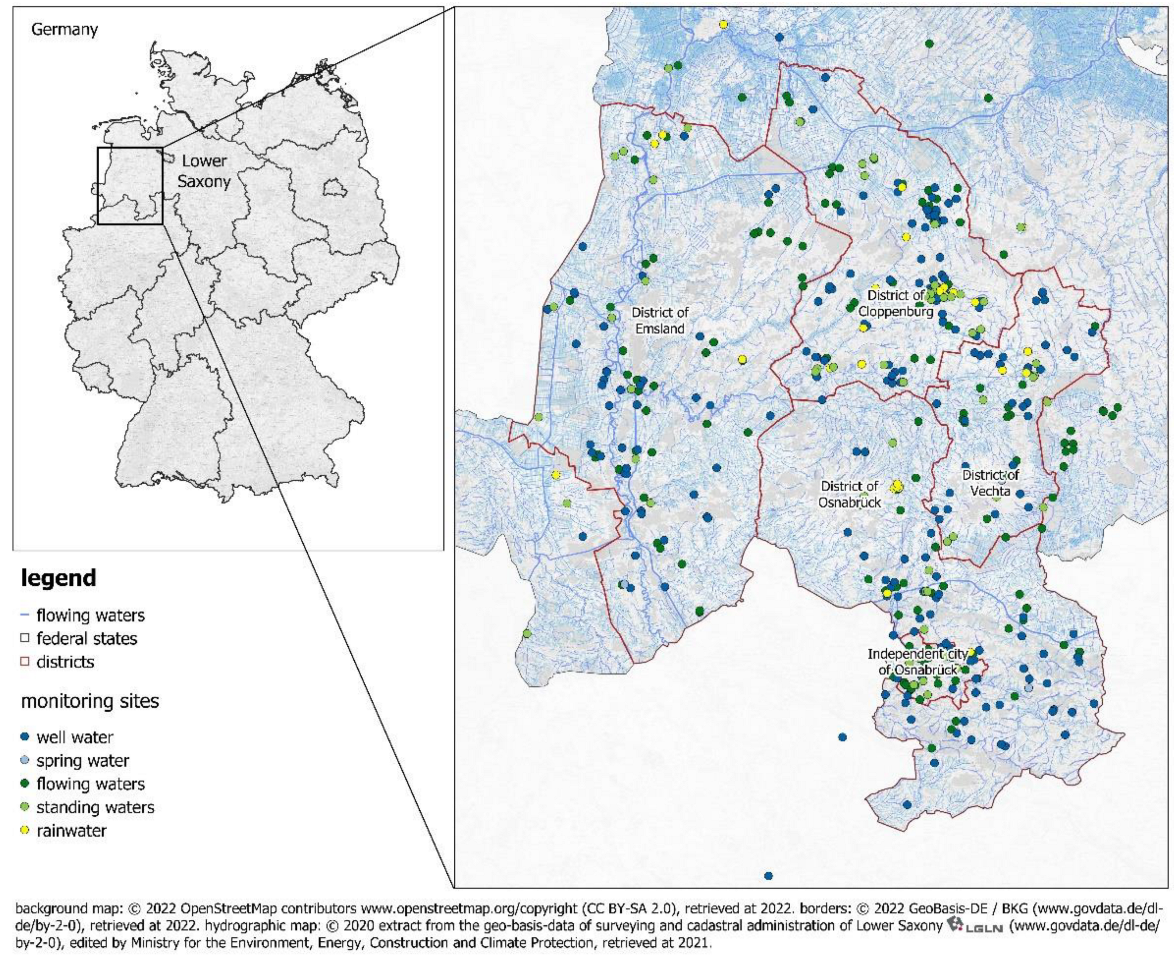

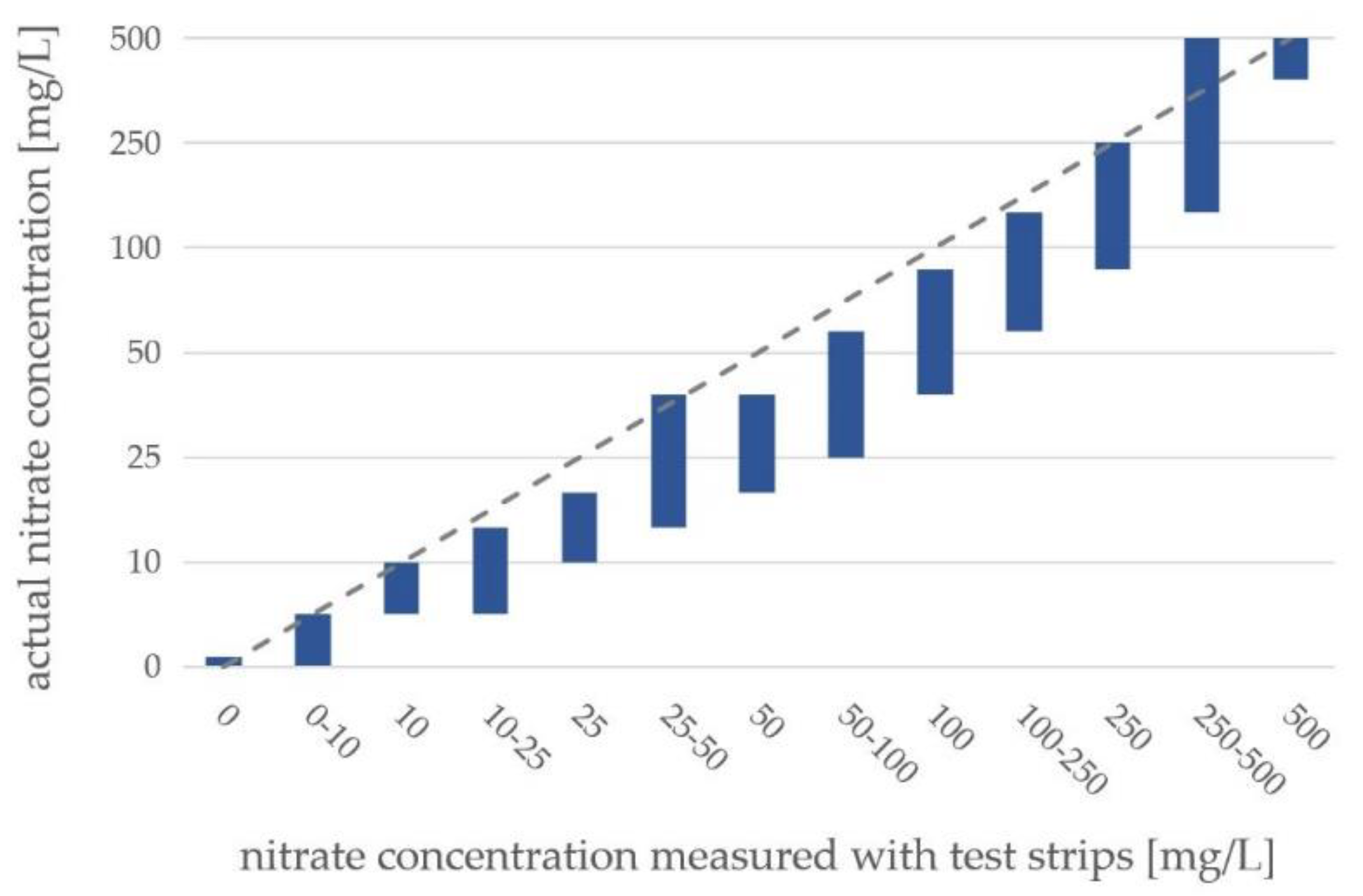
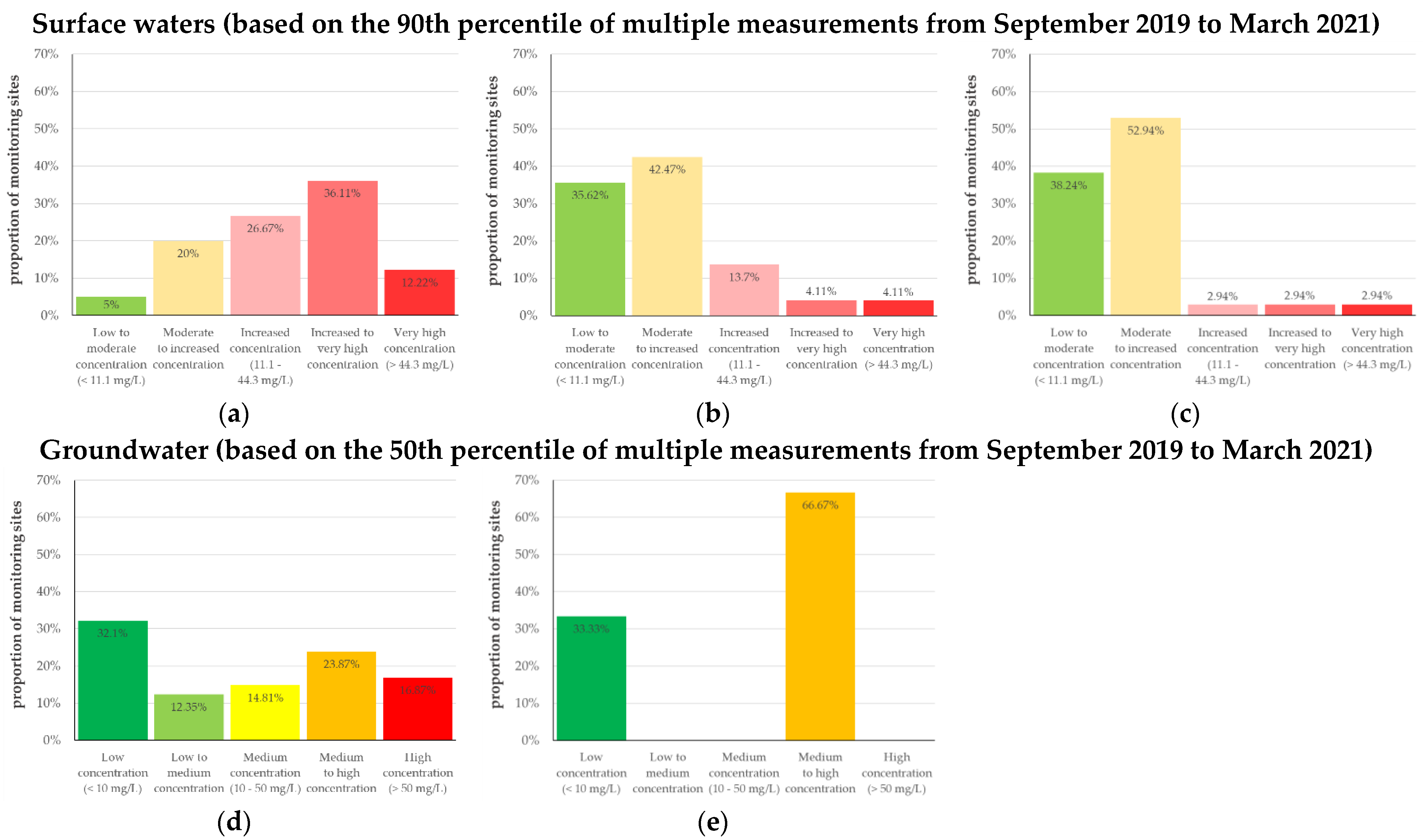

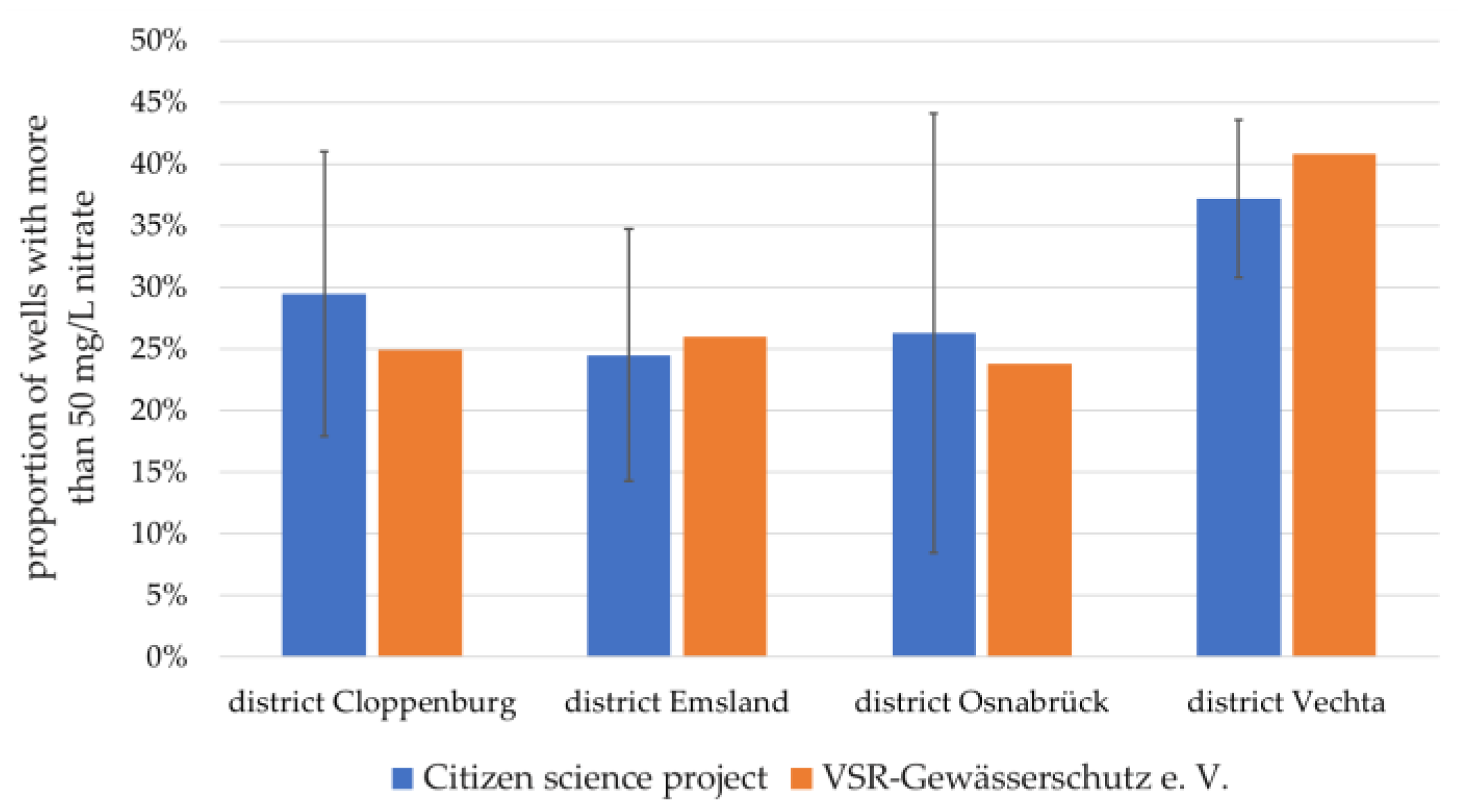
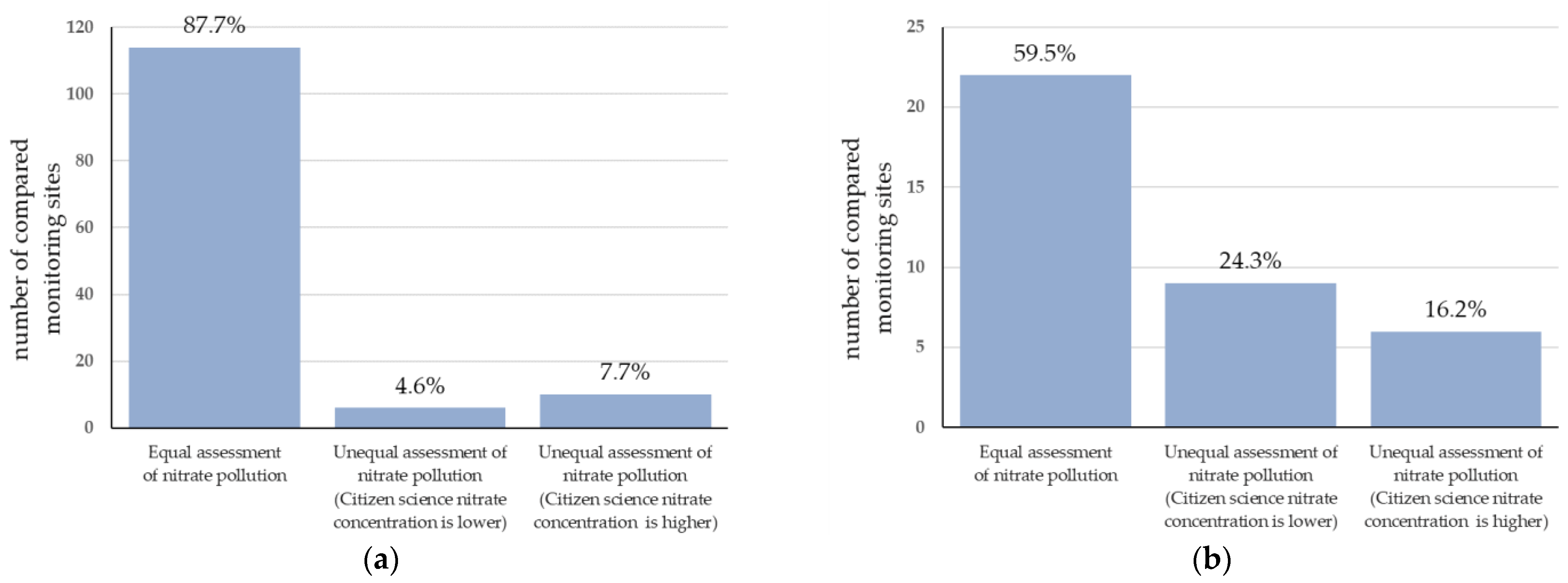
| Water Body Type | Total Number of Monitoring Sites | Artificial Surfaces 1 | Agricultural Areas 1 | Forests and Semi-natural Areas 1 | Sorted out for Spatial Analyses |
| flowing waters | n = 180 | n = 63 | n = 58 | n = 9 | n = 50 |
| Total Number of Monitoring Sites | Urban Fabric 2 | Industrial, Commercial and Transportation Units 2 | Other Land Cover Classes 2 | Sorted out for Spatial Analyses | |
| rainwater | n = 34 | n = 21 | n = 5 | n = 8 | n = 0 |
| Total Number of Monitoring Sites | Geest 3 | Lowland 3 | Upland 3 | Sorted out for Spatial Analyses | |
| well water | n = 243 | n = 87 | n = 97 | n = 58 | n = 1 |
| Water Body Type | Total Number of Monitoring Sites | Sites Sampled at Least Once in | ||||||
|---|---|---|---|---|---|---|---|---|
| Autumn 2019 | Winter 2019/2020 | Spring 2020 | Summer 2020 | Autumn 2020 | Winter 2020/2021 | Each Season | ||
| flowing waters | n = 180 | n = 165 | n = 142 | n = 125 | n = 115 | n = 107 | n = 95 | n = 83 |
| standing waters | n = 73 | n = 52 | n = 46 | n = 30 | n = 21 | n = 22 | n = 18 | n = 13 |
| well water | n = 243 | n = 226 | n = 151 | n = 152 | n = 126 | n = 99 | n = 78 | n = 65 |
| Category | Nitrate Concentration Measured with Test Trips | Classification for Flowing Waters, Standing Waters and Rainwater | Classification for Well and Spring Water |
|---|---|---|---|
| 1 | 0 mg/L; 0 to 10 mg/L; 10 mg/L | Low to moderate concentration (less than 11.1 mg/L 1,2) | Low concentration (less than 10 mg/L 1) |
| 2 | 10 to 25 mg/L; 25 mg/L | Moderate to increased concentration | Low to medium concentration |
| 3 | 25 to 50 mg/L; 50 mg/L | Increased concentration (11.1 to 44.3 mg/L 1,2) | Medium concentration (10 to 50 mg/L 1,3) |
| 4 | 50 to 100 mg/L; 100 mg/L | Increased to very high concentration | Medium to high concentration |
| 5 | 100 to 250 mg/L; 250 mg/L; 250 to 500 mg/L; 500 mg/L | Very high concentration (more than 44.3 mg/L 1,2) | Hight concentration (more than 50 mg/L 1,3) |
Publisher’s Note: MDPI stays neutral with regard to jurisdictional claims in published maps and institutional affiliations. |
© 2022 by the authors. Licensee MDPI, Basel, Switzerland. This article is an open access article distributed under the terms and conditions of the Creative Commons Attribution (CC BY) license (https://creativecommons.org/licenses/by/4.0/).
Share and Cite
Brockhage, F.; Lüsse, M.; Klasmeier, J.; Pietzner, V.; Beeken, M. Citizen Science as an Innovative Approach to Analyze Spatial and Temporal Influences on Nitrate Pollution of Water Bodies: Results of a Participatory Research Project in Germany. Sustainability 2022, 14, 9516. https://doi.org/10.3390/su14159516
Brockhage F, Lüsse M, Klasmeier J, Pietzner V, Beeken M. Citizen Science as an Innovative Approach to Analyze Spatial and Temporal Influences on Nitrate Pollution of Water Bodies: Results of a Participatory Research Project in Germany. Sustainability. 2022; 14(15):9516. https://doi.org/10.3390/su14159516
Chicago/Turabian StyleBrockhage, Frauke, Mientje Lüsse, Jörg Klasmeier, Verena Pietzner, and Marco Beeken. 2022. "Citizen Science as an Innovative Approach to Analyze Spatial and Temporal Influences on Nitrate Pollution of Water Bodies: Results of a Participatory Research Project in Germany" Sustainability 14, no. 15: 9516. https://doi.org/10.3390/su14159516






